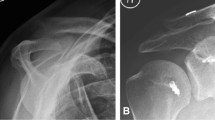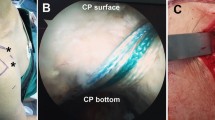Abstract
Purpose
Horizontal instability—especially in the posterior plane—is a common problem after acromioclavicular joint injuries. The purpose was to compare the stability of a single coraco-clavicular tunnel technique and a double coraco-clavicular tunnel technique for coraco-clavicular ligament reconstruction and to examine the influence of an additional acromioclavicular cerclage on the horizontal stability in the acromioclavicular joint.
Methods
21 acromioclavicular joints of human cadaveric shoulders were randomly assigned to the following groups: single coraco-clavicular tunnel technique with horizontal augmented acromioclavicular cerclage (SCT + AC); double coraco-clavicular tunnel technique (DCT); double coraco-clavicular tunnel technique and acromioclavicular cerclage (DCT + AC). The specimens underwent cyclic horizontal testing and were recorded using a 3D optical measuring system.
Results
The displacement and the increase in displacement in relation to the displacement after precondition for SCT + AC were significantly higher after every measured amount of cycles than for DCT (p10 = 0.0023; p5000 = 0.0012) and DCT + AC (p10 = 0.0006; p5000 = 0.0012). There was no significant difference in the total displacement, or in the increase in total displacement between double coraco-clavicular tunnel reconstructed groups with and without additional acromioclavicular cerclage.
Conclusion
Double coraco-clavicular tunnel technique with and without additional acromioclavicular cerclage results in a significant higher stability regarding the horizontal plane in comparison to single coraco-clavicular tunnel technique with acromioclavicular cerclage. Based on the results of this biomechanical in vitro study, the use of an additional acromioclavicular cerclage with single coraco-clavicular tunnel technique may not be indicated in most cases. The effect of an additional acromioclavicular cerclage seems to be negligible, at least in presence of a double-coraco-clavicular tunnel technique reconstruction. Techniques of AC joint reconstruction should focus on the use of double coraco-clavicular tunnel devices.








Similar content being viewed by others
References
Abat F, Sarasquete J, Natera LG et al (2015) Biomechanical analysis of acromioclavicular joint dislocation repair using coracoclavicular suspension devices in two different configurations. J Orthop Traumatol 16(3):215–219
Banffy MB, Uquillas C, Neumann JA et al (2018) Biomechanical evaluation of a single- versus double-tunnel coracoclavicular ligament reconstruction with acromioclavicular stabilization for acromioclavicular joint injuries. Am J Sports Med 46(5):1070–1076
Baumgarten KM, Altchek DW, Cordasco FA (2006) Arthroscopically assisted acromioclavicular joint reconstruction. Arthroscopy 22(2):228.e1–228.e6
Beitzel K, Mazzocca AD, Bak K et al (2014) ISAKOS upper extremity committee consensus statement on the need for diversification of the Rockwood classification for acromioclavicular joint injuries. Arthroscopy 30(2):271–278
Beitzel K, Obopilwe E, Apostolakos J et al (2014) Rotational and translational stability of different methods for direct acromioclavicular ligament repair in anatomic acromioclavicular joint reconstruction. Am J Sports Med 42(9):2141–2148
Beitzel K, Obopilwe E, Chowaniec DM et al (2011) Biomechanical comparison of arthroscopic repairs for acromioclavicular joint instability: suture button systems without biological augmentation. Am J Sports Med 39(10):2218–2225
Braun S, Beitzel K, Buchmann S et al (2015) Arthroscopically assisted treatment of acute dislocations of the acromioclavicular joint. Arthrosc Tech 4(6):e681–e685
Chernchujit B, Tischer T, Imhoff AB (2006) Arthroscopic reconstruction of the acromioclavicular joint disruption: surgical technique and preliminary results. Arch Orthop Trauma Surg 126(9):575–581
Dyrna F, Imhoff FB, Haller B et al (2018) Primary stability of an acromioclavicular joint repair is affected by the type of additional reconstruction of the acromioclavicular capsule. Am J Sports Med 46(14):3471–3479
Dyrna FGE, Imhoff FB, Voss A et al (2018) The integrity of the acromioclavicular capsule ensures physiological centering of the acromioclavicular joint under rotational loading. Am J Sports Med 46(6):1432–1440
Gerhardt C, Kraus N, Pauly S et al (2013) Arthroskopisch assistierte stabilisierung akuter schultereckgelenkverletzungen in Doppel-TightRope-Technik: einjahresergebnisse (Arthroscopically assisted stabilization of acute injury to the acromioclavicular joint with the double TightRope technique: one-year results). Unfallchirurg 116(2):125–130
Grutter PW, Petersen SA (2005) Anatomical acromioclavicular ligament reconstruction: a biomechanical comparison of reconstructive techniques of the acromioclavicular joint. Am J Sports Med 33(11):1723–1728
Hammer N, Löffler S, Feja C et al (2012) Ethanol-glycerin fixation with thymol conservation: a potential alternative to formaldehyde and phenol embalming. Anat Sci Educ 5(4):225–233
Hann C, Kraus N, Minkus M et al (2018) Combined arthroscopically assisted coraco- and acromioclavicular stabilization of acute high-grade acromioclavicular joint separations. Knee Surg Sports Traumatol Arthrosc 26(1):212–220
Jensen G, Ellwein A, Voigt C et al (2015) Doppel-button-fixierung mit minimalinvasiver akromioklavikularer cerclage: arthroskopisch-assistierte Versorgung der akuten Schultereckgelenkinstabilitat (Double button Fixation with minimally invasive acromioclavicular cerclage: arthroscopically-assisted treatment of acute acromioclavicular joint instability). Unfallchirurg 118(12):1056–1061
Kowalsky MS, Kremenic IJ, Orishimo KF et al (2010) The effect of distal clavicle excision on in situ graft forces in coracoclavicular ligament reconstruction. Am J Sports Med 38(11):2313–2319
Kraus N, Haas NP, Scheibel M et al (2013) Arthroscopically assisted stabilization of acute high-grade acromioclavicular joint separations in a coracoclavicular Double-TightRope technique: V-shaped versus parallel drill hole orientation. Arch Orthop Trauma Surg 133(10):1431–1440
Kraus N, Hann C, Gerhardt C et al (2018) Dynamic instability of the acromioclavicular joint. Obere Extremität 13(4):279–285
Mazzocca AD, Arciero RA, Bicos J (2007) Evaluation and treatment of acromioclavicular joint injuries. Am J Sports Med 35(2):316–329
Mazzocca AD, Santangelo SA, Johnson ST et al (2006) A biomechanical evaluation of an anatomical coracoclavicular ligament reconstruction. Am J Sports Med 34(2):236–246
Nuchtern JV, Sellenschloh K, Bishop N et al (2013) Biomechanical evaluation of 3 stabilization methods on acromioclavicular joint dislocations. Am J Sports Med 41(6):1387–1394
Pastor MF, Averbeck AK, Welke B et al (2016) The biomechanical influence of the deltotrapezoid fascia on horizontal and vertical acromioclavicular joint stability. Arch Orthop Trauma Surg 136(4):513–519
Saier T, Venjakob AJ, Minzlaff P et al (2015) Value of additional acromioclavicular cerclage for horizontal stability in complete acromioclavicular separation: a biomechanical study. Knee Surg Sports Traumatol Arthrosc 23(5):1498–1505
Schär MO, Jenni S, Fessel G et al (2019) Biomechanical comparison of two biplanar and one monoplanar reconstruction techniques of the acromioclavicular joint. Arch Orthop Trauma Surg 139(6):779–786
Scheibel M, Droschel S, Gerhardt C et al (2011) Arthroscopically assisted stabilization of acute high-grade acromioclavicular joint separations. Am J Sports Med 39(7):1507–1516
Walz L, Salzmann GM, Fabbro T et al (2008) The anatomic reconstruction of acromioclavicular joint dislocations using 2 TightRope devices: a biomechanical study. Am J Sports Med 36(12):2398–2406
Weiser L, Nüchtern JV, Sellenschloh K et al (2017) Acromioclavicular joint dislocations: Coracoclavicular reconstruction with and without additional direct acromioclavicular repair. Knee Surg Sports Traumatol Arthrosc 25(7):2025–2031
Wellmann M, Zantop T, Petersen W (2007) Minimally invasive coracoclavicular ligament augmentation with a flip button/polydioxanone repair for treatment of total acromioclavicular joint dislocation. Arthroscopy 23(10):1132.e1–e5
Author information
Authors and Affiliations
Corresponding author
Ethics declarations
Conflict of interest
The authors declare that they have no conflict of interest.
Funding
We acknowledge support from the “Deutsche Arthrose Hilfe e.V.”.
Ethical approval
Institutional approval for the use of the post-mortem tissues of 126 the donors was obtained. For this reason there is no specific number from the ethics committee.
Additional information
Publisher's Note
Springer Nature remains neutral with regard to jurisdictional claims in published maps and institutional affiliations.
Rights and permissions
About this article
Cite this article
Theopold, J., Schöbel, T., Fischer, JP. et al. Acromioclavicular joint reconstruction: an additional acromioclavicular cerclage does not improve horizontal stability in double coraco-clavicular tunnel technique. Knee Surg Sports Traumatol Arthrosc 27, 3827–3834 (2019). https://doi.org/10.1007/s00167-019-05674-1
Received:
Accepted:
Published:
Issue Date:
DOI: https://doi.org/10.1007/s00167-019-05674-1




